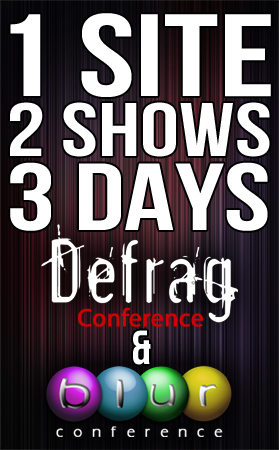Over the years, Defrag has covered a variety of topics — from social business to the semantic web to social media to big data, etc. And, as the community has really formed around Defrag, we’ve taken on what some have thought are “TED-like” qualities (big idea talks given by world class speakers). While that’s true, it doesn’t mean that we’ve abandoned trying to posit a thesis and then let that thesis play out over two days of talks. Of course, not all of the presentations fall directly in-line with the thesis, but I do think they contribute to the overall conversation.
That said, this year, I’ve been kicking around a thesis in my head: namely, that we’re at the beginning of a 20 year cycle of innovation in enterprise IT; one that’s similar in impact to the last 20 year cycle of innovation in enterprise IT.
The thesis is young and untested, so I’ll ask that you be gentle, but it goes something like this…
The last 20 year innovation cycle in enterprise IT saw the PC, the spreadsheet and the internet (I mean that as broadly as possible — i.e., to include email) completely remake what it means to leverage technology to do business. That cycle began in the 1981-ish (80-83) timeframe, and ran for 20 years, culminating in the enterprise side of the dot com boom (ERP systems, b2b marketplaces, ASPs [that's early cloud computing for you youngins out there], etc) in 2001.
When we look back on the current 20 year innovation cycle in enterprise IT, we’ll see that it started in the 2002-2005 timeframe with the driving factors of disruption being cloud computing, mobile, big data, and social — where the lynchpin of it all is the API and the renaissance of the enterprise developer. That’s right, the developers are now the “kingmakers“. (side note: I picked 2002-2005 as the nexus of beginning, as those dates are bookended by the launch of AWS and Box.net; it’s a bit random and open to tons of arguing by the clouderati.)
This new cycle of innovation will have as much if not more impact on what IT in the enterprise means going forward as the last cycle did. And, if history does indeed rhyme, this current cycle will find itself ending in the 2022-2025 timeframe — most likely with some sort of bubble-ish-y ending that sends the tech industry into another 2-3 “nuclear winter.”
In other words, we’re just at the beginning of this.
So, while there may be a bubble in consumer this or social-local-mobile that, the innovation in the enterprise is poised to run for another 10 years (a decade; that’s a LONG TIME). Somewhere in this cycle, as the initial burst of “cloud” innovation wears off, we’ll get a secondary round of innovation that will propel us forward into the bubble-ish phase. If the analogy holds (where PCs and Spreadsheets started it in 1981, and Netscape kicked off the second innovation round in 1994), then our “secondary wave” of innovation should hit around 2015 to 2017 (13-ish years after this all started). There’s a lot of work to be done, and a massive wave of change is hitting that the enterprise will be racing to catch up with. And when it’s all over (in 2027-ish), enterprise IT won’t resemble what it did pre-2002.
We’ll be digging into this in many, many ways at Defrag this year — everything from Kevin Kelly talking about the emergence of a technology super-organism, to a session on this 20 year cycle idea, to Peter Levine of Andreesen Horowitz talking about the renaissance of enterprise developers, to Kwin Kramer of Oblong presenting about the massive change in UI’s and how that plays into things.
In short, it’s gonna set the stage for the next decade of what’s going on and where the money, innovation and startup heat is gonna happen. And it’d be a shame if you don’t get the head start you’ll need. I hope you’ll join us.
Hat-tip to Paul Kedrosky and Phil Becker, both of whom have acted a crucial contributors, creators of, and sounding boards for this thesis.

